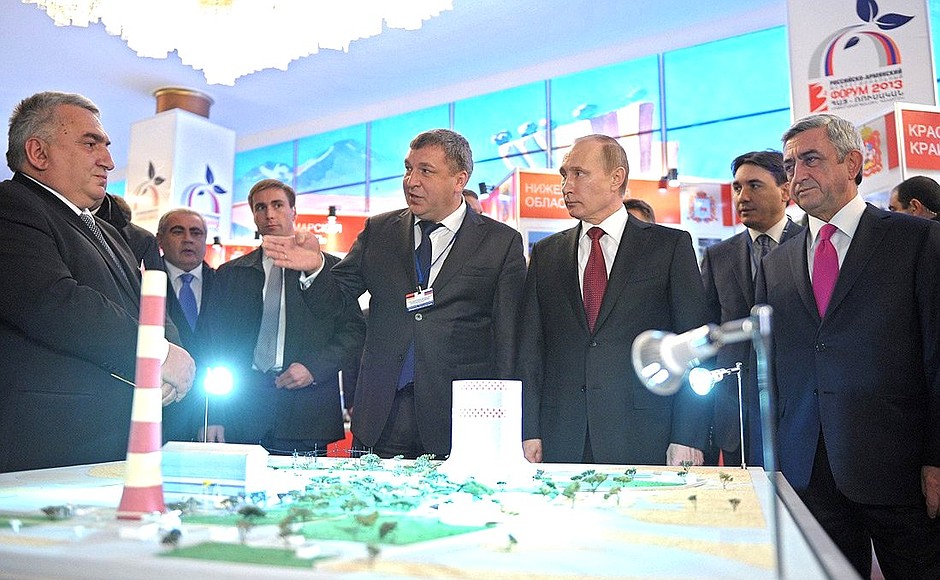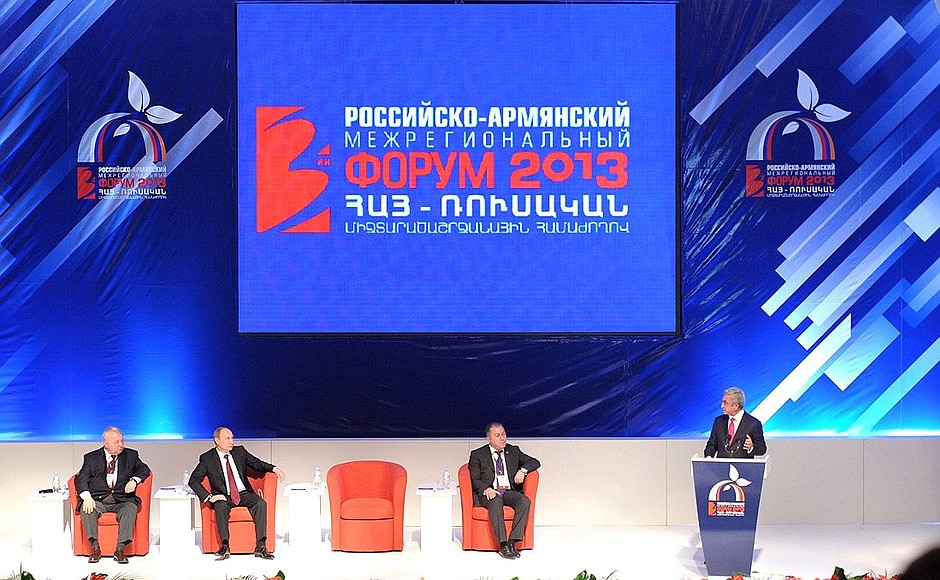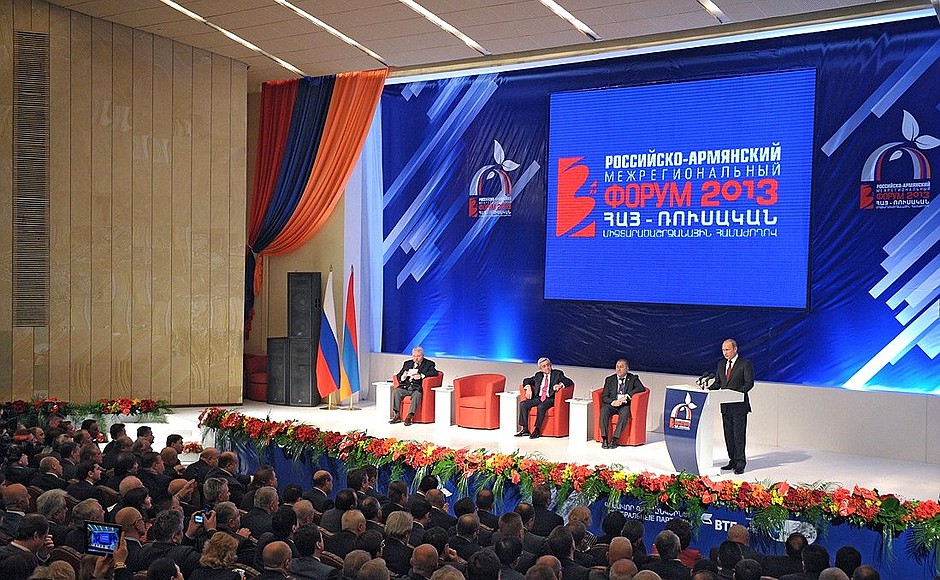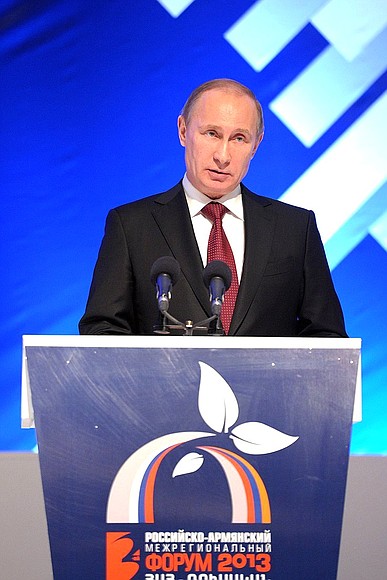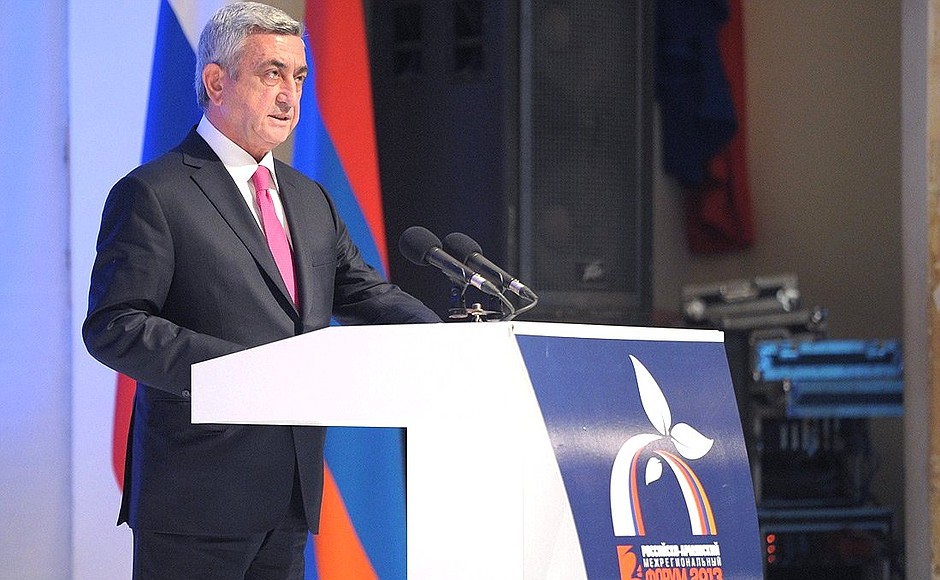President of Russia Vladimir Putin: Colleagues, Mr Sargsyan,
It is a great pleasure to greet you all at this third Russian-Armenian Interregional Forum.
Twenty five years ago, Gyumri lived through a devastating earthquake, as the President recalled just before, and became a symbol of the mutual support and close ties that bring Russia and Armenia together. These traditions of trust and friendship continue to define the partnership and alliance that we have in our bilateral relations today.
Russia is Armenia’s main trade and economic partner. According to our data, our trade grew by more than 20 percent in 2012 and came to more than $1.2 billion. Accumulated Russian investment in Armenia comes to more than $3 billion and accounts for more than 40 percent of all foreign investment in Armenia.
We are carrying out big infrastructure and energy projects together. Mr Sargsyan and I just watched the launch of operations at the Hrazdan thermal power station’s fifth unit. Russian investment in this project came to more than $300 million. Our other promising projects include increasing capacity at the Sevan-Hrazdan hydroelectric power station, extending the Armenian nuclear power plant’s service life, and modernising Armenia’s railway network.
Interregional cooperation plays a big part in developing our trade and economic ties. All of Armenia’s regions and around 70 Russian regions are already involved in this work. Moscow and St Petersburg, Rostov, Sverdlovsk and Ulyanovsk regions and Krasnoyarsk and Stavropol territories have the most active ties with partners in Armenia.
Around 30 interregional agreements on trade and economic cooperation and scientific and cultural ties have been signed. Our education sector ties are also growing fast. My colleague spoke about this just now. Kazan University is working together with Armenia’s State Engineering University. An Armenian cultural centre has been opened in Kaliningrad, and an Armenian language centre has been opened in Pyatigorsk.
Cooperation between our capital cities has always been close. In 2012, Moscow’s trade with Armenian partners increased by 21 percent and came to $270 million. A programme was approved on exchange of experience between Moscow and Yerevan in the housing and utilities sector, transport, and healthcare. The Days of Yerevan event at the end of November in Moscow was a success. Yerevan hosted the Days of St Petersburg event on October 14–16.
See also
It is important to continue developing our mutually advantageous partnership’s potential, draw small and medium-sized business into interregional cooperation, expand youth contacts and tourism, and organise contacts between the diaspora groups, between civil and public groups, as was already mentioned here today.
Armenia’s desire to join the integration organisations in the post-Soviet area – above all the Customs Union, the Common Economic Space, and the future Eurasian Economic Union – also opens up big new opportunities for developing multifaceted cooperation. I was discussing this before with Mr Sargsyan during our brief conversation on the way from the airport. What can I say here? It is simply a case that Armenia’s experts, specialists and economists made a thorough calculation of all the benefits and advantages to be gained, and all the possible preferences that this kind of close cooperation within the integration organisations offers, and made their choice. This is the sovereign choice of Armenia’s people and government. Russia will of course do everything it can to support Armenia in developing this cooperation.
We see Armenia as a full-fledged participant in integration. The three Customs Union member countries approved this policy at the Supreme Economic Council’s October meeting in Minsk.
Building on earlier agreements, the practical preparations for Armenia’s entry into the Customs Union have already begun. As Mr Sargsyan said just before, consultations are underway now with the Eurasian Economic Commission and a large package of legal, administrative and other documents are expected to be approved. We will continue to help our Armenian friends to make the accession process move along as effectively as possibly.
Russia, Kazakhstan and Belarus have already made noticeable gains by taking part in the Customs Union and Common Economic Space. Despite the unfavourable foreign economic situation over these last years, these three countries’ GDP grew by 1.7 percent over the first half of 2013.
Removing customs and administrative barriers facilitates trade growth. Trade within the Customs Union and Common Economic Space grew by a further 2 percent over January-August this year. Let me note too that this 2 percent does not include the fuel and energy sector. If we count this sector too, the figure would be considerably higher of course.
Competition between national jurisdictions is a new phenomenon that has also emerged now. Businesses from the Customs Union countries can choose where to register their companies. This is a challenge for the state agencies, but at the same time it is also an incentive to offer a more comfortable environment for doing business.
I am sure that Armenia’s joining the Eurasian integration project will give its economic potential a big boost and help it to keep improving its investment climate and develop direct business contacts, including at the interregional level.
I hope that you will make these and other issues the subject of your engaged discussions today, and I, like Mr Sargsyan, wish you success.
Mr Sargsyan mentioned Vasily Agapkin [Russian military conductor and composer], who lived here in Gyumri and wrote the famous march ‘Farewell of Slavyanka’. He wrote the march with the military action in the Balkans on his mind. As for the Trans-Caucasus region, Russia will never leave this region. On the contrary, we will make our place here even stronger. (Applause) We will strengthen our position here, drawing on the best of what our forebears left us and with the support of good relations with all countries in the region, including Armenia.
Thank you very much for your attention.
